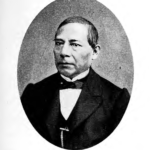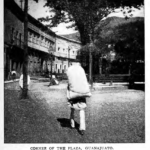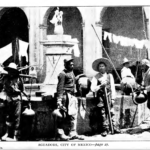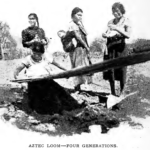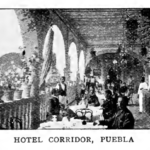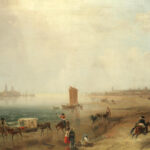Harriott Wight Sherratt
Hailing from Rockford, Illinois, Harriott Wight Sherratt’s experience in the writing world ranged from poems in children’s magazines to creating the 1894 “Women’s Edition” of the Rockford Morning Star, an experiment in which women from the local aid society wrote an entire edition of the paper. Sherratt came from a wealthy background and valued education, exhibited by her $50,000 (the equivalent of nearly $1 million today) donation to the creation of a new Rockford College library in 1934. However, Sherratt’s most well-known legacy is the popular travelog Mexican Vistas: Seen from the Highways and Byways of Travel published in 1899.
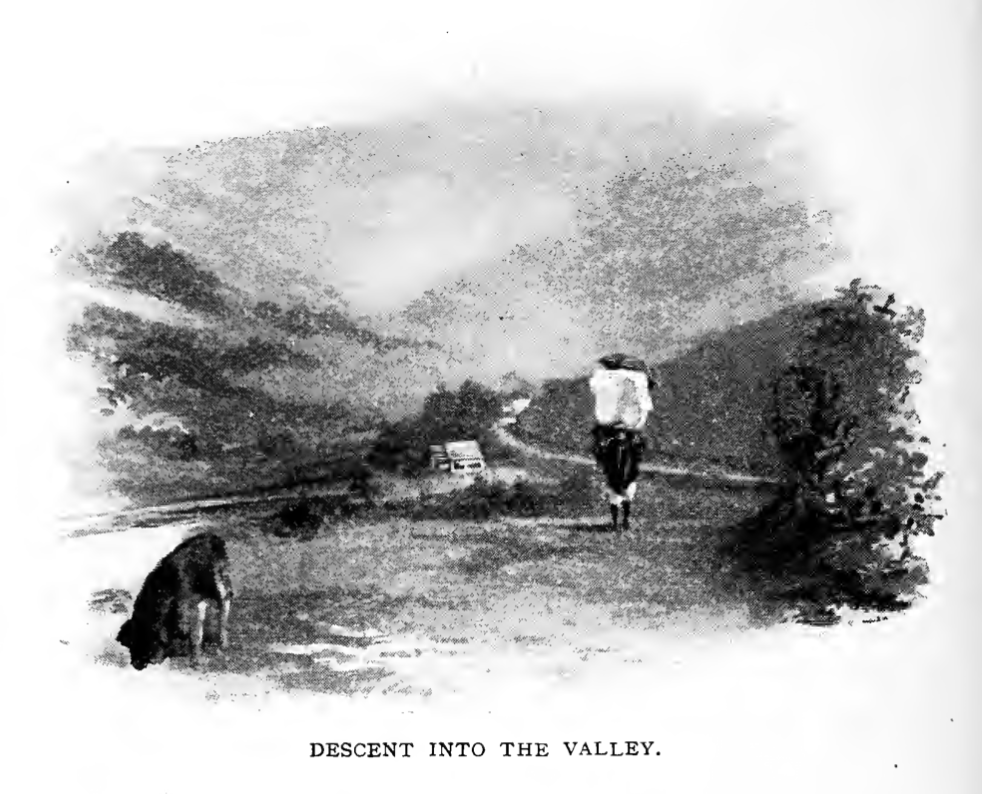
Image Gallery
Themes
Throughout Sherratt’s work, she uses stereotypes that associate behavioral characteristics, such as laziness or alcoholism, with ethic background. The racist understanding of genetic traits exemplifies the need to view the work of Sherratt and other Americans not as a factual description of a place, but deeply influenced by previous conceptions and understanding of race and nationality.
“The people of Mexico are of three races. The white race, which comprises about twenty per cent of the population, is of Spanish or European extraction. The people of this race generally hold the government offices, and consider them- selves the superior class…The Mexican Creoles or mestizos, who comprise nearly one-half of the population, are the descendants of the Spaniard and the Indian. They are the working people of the country—the skilled artisans, the mechanics, the soldiers and the higher servants. As would naturally be expected in a conquered nation, the real owner of the soil, the Indian, or the half-breed in whose veins the Indian blood predominates, is the lowest of all the classes. He is the so-called peon, the man who does the hard work on the haciendas, the toiler, the drudge,” (pp.42-43).
“The mountain Indian is a much finer man than the Indian of the plain or the hamlet, although I fear that he has, with the Indian virtues, the Indian imperfections a lack of ambition and a tendency to drunkenness,” (p.43).
“This half-breed is not born to the inheritance of joyousness that the Cuban is, whose few drops of negro blood put quicksilver into his nature. The Mexican has all the pomposity of the Spaniard and all the stolidity of the Indian,”(94-95).
When recounting her impression of Mexican women, it is clear that Sherratt values feminine independence and capability, qualities she may have seen in herself as she completed the type of adventurous travel often reserved for men. While pitying the Mexican women that live “dull” lives supporting their families, Sherratt applauds the “new woman” in Mexico that is in control of her life, therefore associating those qualities with a type of modernization. However, as seen in her description of the President Diaz’s wife, Sherratt’s still highly values those that are more traditional “gentlewomen”.
“The Mexican women do not travel, and no arrangement for the comfort of the sefioras is made on the railway trains or in the hotels. Our poor sisters must have a very dull life. They are expected to go to church and pray for their husbands who will not pray for themselves, take care of the countless babies of the household, and keep their faces properly powdered,” (p.155).
“I found the “new woman” greatly in evidence in Zacetecas. She didn’t know she was a new woman —bless her—but she certainly was one. She fought her own battles, and went into business on her own account, and no man said her nay…A baby slung to her back proclaimed the fact that she had not sacrificed private to public duties, but that her “sphere” included all,” (pp.48-49).
“The most popular woman in the country is Senora Diaz, the sweet-faced wife of the president. This simply attired, gracious wife of a great ruler is a thorough gentlewoman. She received us with the most graceful courtesy, paying us the greatest compliment possible to pay a stranger by addressing us in our own tongue, and I blushed as I responded to her elegant English, knowing that I could not speak fifty words in her own language. Senora Diaz spoke in the kindliest manner of the United States, and I was glad to answer her honestly that we were proud of our young sister republic and anxious to be on sisterly terms with her,” (p.114).
Regarding Mexican politics, Sherratt consistently shows support and admiration for the Mexican president Porieito Díaz, primarily due to the stability associated with his administration. His 34 year term from 1884 -1991, was from a time of redefinition, centralization and recovery. The military hero Díaz led the country to overcome some of its great challenges of past decades including an erratic economy and political division. However, Díaz’s supposed success did not benefit everyone, as his presidency also facilitated great concentration of wealth, dispossession of lands, and the violent persecution of opposition at the hands of rural police.
“After the execution of the Emperor Maximilian at Queretaro, President Benito Juarez, a full- blooded Indian, ruled Mexico wisely and firmly. He died in 1871. In 1876 General Porfirio Diaz headed a successful revolution, and was elected to the presidential chair. Since then Diaz, who is a patriot and a wise ruler, has been many times re-elected president,” (p.40).
“Although Mexico prides herself upon being a republic, and although loyal Mexicans almost always speak of the country as ”la republica,” and seldom as “Mexico,” still the government is not, inoursenseoftheword,reallyarepublic. Happily for Mexico, the franchise, as we know it, does not exist. The power is vested in a strong government, with a strong man at its head. Diaz has been president for eighteen years. He has continued the wise poHcy of the great Juarez, and has given to the country railroads, telegraphs, free schools, and libraries. He is the leader of the Liberal party, the party which stands for freedom and enlightenment, as opposed to the more conservative policy of the Church,” (p.114-115).
“During the administration—or rather lack of administration—of Diaz’ predecessor, President Gonzales, the Monte de Piedad suffered with other government institutions, and narrowly escaped bankruptcy. President Diaz has, however, put all government interests on a stable and, let us hope, a lasting basis,” (p.105).
The Mexican – American War, a two-year conflict in which the U.S. annexed over half of Mexico’s territory is often present in Sherratt’s mind as she visits cities and towns that American troops attacked and destroyed. Despite her general allegiance to US superiority, Sherratt has sympathetic leanings to the pain suffered in the war. However, Sherratt never truly questions the US army’s choices and values, seeing the attack as the only possible step forward.
“Although I am aware that the officers and soldiers of the United States’ army could, under the circumstances, not do otherwise, still, I am never less proud of them than when I read the annals of the Mexican War,” (p.278).
“In spite of mental reservations on the subject of the Mexican war, I am so proud to have been born in the United States, that, if I could fight for the dear old land with baking powder instead of gunpowder, I would be one of her most valiant defenders,” (p.284-285).
Sherratt’s understanding of Mexico and the US is one of siblings or specifically sisters, in which the more mature US can lead Mexico to the height of “civilization”. In Sherratt’s view, Mexico’s more traditional tendencies and lack of development means that it is inherently behind and below the standard of the U.S. This viewpoint places the U.S. way of life as both the norm, never questioning that other countries would want to be anything but like the U.S.
“Although [their] point of view may often seem to us childish and puerile, we may, nevertheless, while leading our neighbors up the steep grade of civilization, also chance to learn something of them,” (p.20).
“It is to be hoped…that the two sister republics, side by side, may unite in a kindly emulation for all the triumphs of free religion and civilization,” (p.117).
"It is to be hoped...that the two sister republics, side by side, may unite in a kindly emulation for all the triumphs of free religion and civilization," (p.117).
Image: “Vera Cruz, and Castle of San Juan D’Ulloa” by Daniel Thomas Egerton (1830)
Places Visited
Zacatecas is the first major city visited by Sherratt in Mexico. From the landscape to the social scene, Sherratt is confronted with cultural characteristics quite unfamiliar to her before.
“Zacetecas is more than 8,000 feet above the sea, and the rare air of the high altitude renders less apparent the sickening smells that one naturally expects to find in a Mexican city with a swarming population,” (p.48).
“The center of social life in Zacetecas seems to be the plaza near the Cathedral, where the band plays in the evening and the young people promenade. The youths form in line and march in one direction while the maidens march in the opposite one. This is really another market on the plaza, where most of the Mexican marriages are made,” (p.51).
Compared to Zacatecas, which tended to be poor, Guanajuato was a city of success and wealth. Supported by their profitable trade in silver, the city boasts beautiful landmarks such as the opera house which drew Sherratt’s eye.
“We were also told that one-sixth of all the world’s supply of silver comes from Guanajuato—another statement I am not prepared to defend with my dying breath. At all events, Guanajuato is a very rich town,” (p.67).
“There is a beautiful opera house opposite the [Guanajuato] plaza, the finest I ever saw—not even excepting the Grand Opera House in Paris, which may be more costly, and certainly is larger, but not nearly so beautiful,” (p.67).
“Our first introduction to the city of the old Aztecs could hardly be considered satisfactory. The town was crowded by an excursion party, and the few hotels were full,” (p.82).
“Public transit in the City of Mexico is cheap, and fairly comfortable. The intricacies of the street- car lines are easily mastered. They all start from the principal plaza, and return there. The first-class cars are painted yellow, the second-class green. In both classes of cars the men and often the women smoke continually, so that one who is sickened by tobacco smoke would do well to avoid them,” (pp.82-83).
“The great sewage canal which has been so long in progress will, if ever finished, be a boon to the City of Mexico; for with proper sanitary conditions the Capital will be one of the healthiest cities in the world,” (p.28).
Out of all locations visited throughout Mexico, Veracruz is unique in that it is depicted almost entirely negatively. From swindling to the sewage, Sherratt finds almost no redeeming qualities.
“Except in Vera Cruz, we found the people [of Mexico] almost invariably honest,” (p.34).
“The town of Vera Cruz has every reason to be the unhealthiest place in the world, for, in addition to the deadly climate, the sewage runs in open gutters by the side of the street, and the pedestrian and the burro alike stir up the living mass,” (p.66).
“In spite, however, of the ecclesiastical atmosphere of the city, the sentiment of the people does not seem to me really religious.Indeed, the Holy Week services, with the clanging of meaningless bells, the high, dreary intonations of the priests, the swinging of the censers by irreverent boys, and the flashy music, seemed more like an auction than a religious service, and I could not help contrasting it with some most beautiful and impressive Holy Week services I once heard in the famous Cathedral of Amiens., ” (pp.178-179).
In Oaxaca, Sherratt dramatically praises its climate and environmental characteristics, such as mountain water. Mexico and its experiences are thus presented as beyond the familiarity of the earthly world—namely countries of Europe—and instead completely exotic.
“It was late in the evening when we at length reached Oaxaca and were met by a blessed American landlord, who took us to a blessed American hotel, where we ate once more the delightfully indigestible fried potato and drank our fill of the pure mountain water. No vintage in France or Italy knows the secret of that bouquet—the nectar of the gods—which after our long thirst we quaffed with the appetite of modern Jupiters. And here, too, in Oaxaca, we found the first really perfect climate we had seen in Mexico. All our heavy wraps came off and I reveled in the sunshine and in shirtwaists,” (pp.192-193).
In addition to the well-known city destinations, Sherratt establishes an identity as an adventurous traveler by going to remote Indigenous villages throughout the Sierra Madre Del Sur mountain ranges. As seen by the quote describing her human-supported carriage, her exploratory experience is still one of relative comfort provided by the people whose land she is entering.
“It was nearly noon when they finally appeared with the chariot which was to transport me to higher regions. This chariot was a high-backed wooden chair with a broad foot rest, and a white cotton canopy overhead which could be drawn over the face or thrown back. I seated myself in the chair, the Indian porter knelt, placed one of the two bands around his forehead, and the other around his shoulders, rose slowly like a camel and trotted off with me…They were all strong, robust Indians accustomed to burdens of at least two hundred and fifty pounds, so that my conscience did not too much reprove me, although I must confess that I had all the time the feeling that I was making of a human soul a beast of burden,” (p.224).
Due to its similarity to America, the exotic factor which drives Sherratt’s interest in many previous Mexican locations is lower in Monterrey. However, Monterrey is of note because it was a site of great violence during the Mexican-American war. Visiting does cause Sherratt to be more critical of American actions.
“Monterey can hardly be called a Mexican city. It has a large and constantly increasing American population, and American ways of doing business. Here, for the first time in Mexico, we saw drawn-work and opals take on American prices, and we also found American prices at the hotel-accompanied by the very poorest kind of Mexican food and service. It will not be long, however, before Monterey…will lose the last vestige of its Mexican picturesqueness, and become an ordinary American city,” (p.227).
“After the fall of the citadel, General Worth, commanding the United States forces, entered the town, but finding its streets swept by the fire of the Mexican artillery, his troops broke through the walls of the houses, in this manner making their way from block to block, while the sharpshoot- ers from the roofs poured a ceaseless shower of bullets upon the heads of the city’s brave defenders. Although I am aware that the officers and soldiers of the United States’ army could, under the circumstances, not do otherwise, still, I am never less proud of them than when I read the annals of the Mexican War,” (p.278).
"After the fall of the [Monterrey] citadel, General Worth, commanding the United States forces, entered the town, but finding its streets swept by the fire of the Mexican artillery, his troops broke through the walls of the houses, in this manner making their way from block to block, while the sharpshooters from the roofs poured a ceaseless shower of bullets upon the heads of the city's brave defenders. Although I am aware that the officers and soldiers of the United States' army could, under the circumstances, not do otherwise, still, I am never less proud of them than when I read the annals of the Mexican War." (p.278)
Image: “Battle of Monterrey, 1846”, lithographed and published by Sarony & Major (c.1846)
Primary Sources
- Harriot Wight Sherratt, Mexican Vistas: Seen from the Highways and Byways of Travel
- “Among the New Books” Review of Mexican Vistas: Seen from the Highways and Byways of Travel. Chicago Tribune, (June 18, 1900).
- Adachi Kinnosuke, “Travel” Review of Mexican Vistas: Seen from the Highways and Byways of Travel, . The Los Angeles Times, (January 21, 1900)
- “An Opportunity for New Authors” Review of Mexican Vistas: Seen from the Highways and Byways of Travel, . The New York Times, (January 20, 1900).
- “What One See in Mexico” Review of Mexican Vistas: Seen from the Highways and Byways of Travel. The Brooklyn Daily Eagle. New York City, (January 14, 1900).
Secondary Sources
- David W. Tschanz, Yellow Fever and the Strategy of the Mexican-American War
- Beau D.J. Gaitors, Commerce, conflict, and contamination: yellow fever in early-independence Veracruz in the US imaginary, 1821-1848
- Jason Ruiz, Desire among the Ruins: The Politics of Difference in American Visions of Porfirian Mexico
- Peter Henderson, Virginia Garrard, Bryan McCann, Latin America in the Modern World
- Cynthia Enloe, Bananas, Beaches & Bases : Making Feminist Sense of International Politics
- Jason Mason Hart, Empire and Revolution: The American in Mexico Since the Civil War
